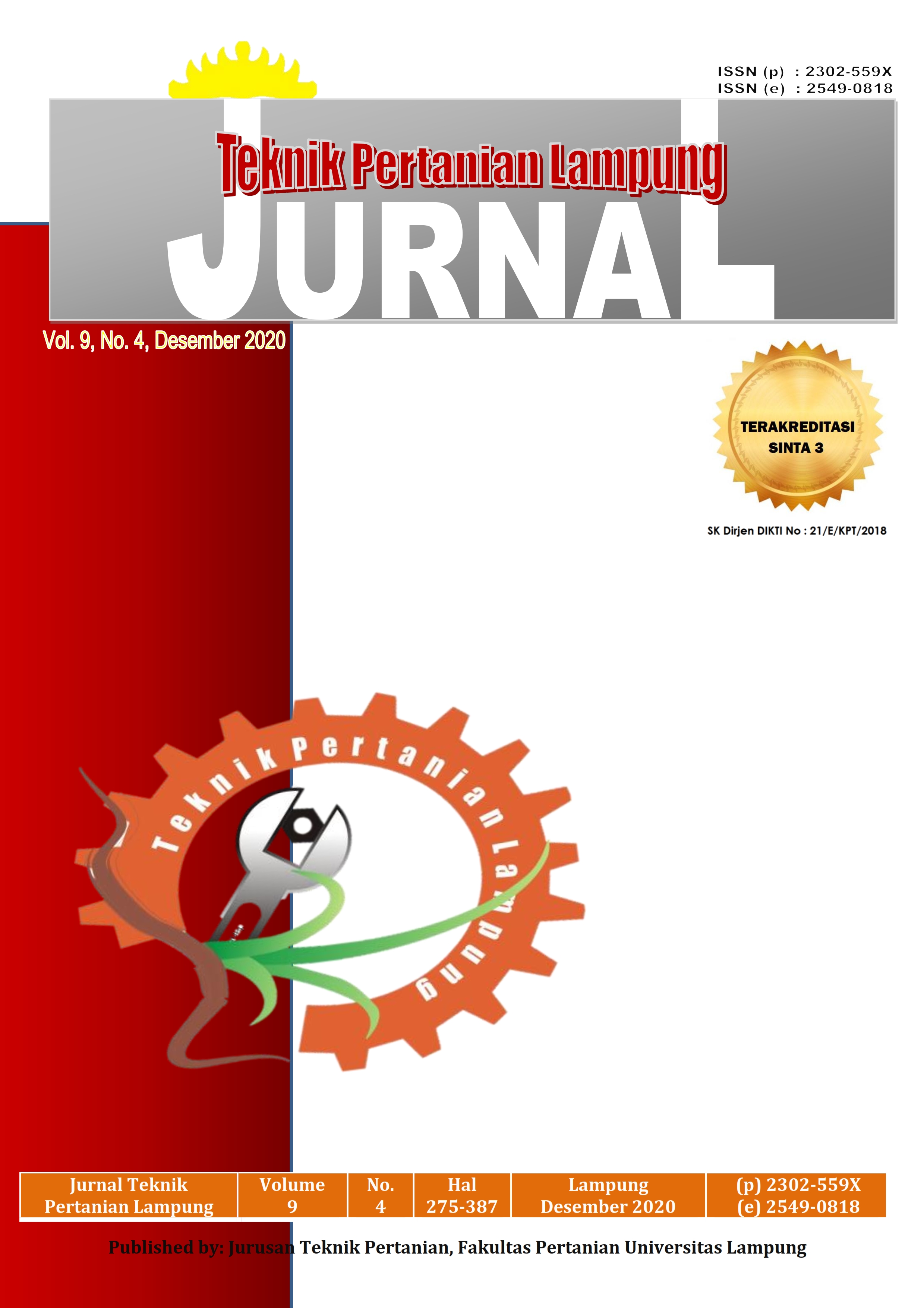THE EFFECT OF CHITOSAN COATING ON COLOR AND BRIX OF RED GRAPES (Vitis vinivera) IN STORAGE
DOI:
https://doi.org/10.23960/jtep-l.v9i4.361-366Abstract
Fruits are a type of perishable agricultural product. One of the post-harvest handling efforts to maintain the freshness of the fruit is chitosan coating. Research has been carried out on various level concentration of chitosan as a coating for grapes (Vitis vinifera) and storage time. This study aims to determine the effect of chitosan concentration on water content, color and brix of red grapes after storage. Chitosan coating was carried out by immersion methods at various levels of chitosan concentration, namely 0%, 0.5%, 1%, 1.5% and 2% (w/v) with immersion times of 30 seconds and 60 seconds. Based on the statistical test, it is shown that the chitosan concentration of 1.5% (w/v) with immersion time of 60 seconds and storage time on the 5th day is the most optimum for the brightness level of the grapes because the chitosan layer can close the pores of red grapes so that the respiration process aerobic and CO2 which affect color can be inhibited by chitosan solution.
Keywords: Chitosan, edible coating, grape, post harvest, shelf life
References
Hernani, 2005,Tanaman Berkhasiat Antioksidan, Penebar Swadaya, Jakarta.
Moalemiyan, M., Ramaswamy, H. S., and Maftoonazad, N. 2011. Pectin-Based Edible Coating For Shelf-Life Extension Of Ataulfo Mango. Journal of Food Process Engineering 35 (4): 572-600.
Novaliana, N. 2008. Pengaruh Pelapisan dan Suhu Simpan Terhadap Kualitas dan Daya Simpan Buah Nenas (Ananas Comosus L Merr). [Skripsi]. Departemen Agronomi dan Hortikultura Institut Pertanian Bogor. Bogor.
Pantastico, B. 1986. Fisiologi Pasca Panen. Penanganan dan Pemanfaatan Buah-buahan dan Sayur-sayuran Tropika dan Subtropika. Terjemahan oleh : Kamariyani. Gadjah Mada University Press.Yogyakarta.
Pujimulyani, D. 2012. Teknologi Pengolahan Sayur-sayuran dan Buah-buahan. Graha Ilmu. Yogyakarta.
Rowe, R.C., Sheskey P.J., Cook W.C., and Quinn M.E., 2009, Handbook of Phaermaceutical Excipients,sixth editon,Pharmaceutical Press and American Pharmacists Associations, London and Washington DC.6. Shiekh, R.A., Malik, M.A., Al-thabaiti, S.A., and Shiekh, M.A. 2013. Review: Chitosan as a Novel Edible Coating for Fresh Fruits. Food Sci. Technol. Res., 19 (2): 139 – 155.
Soekarto, S. T. 1985. Penelitian Organoleptik untuk Industri Pangan dan Hasil Pertanian, Bharata Karya Aksara, Jakarta.
Suketi, K., Poerwanto, R., Sujiprihati, S., Sobir, and Widodo, W.D. 2010.Studi Karakter Mutu Buah Pepaya IPB. Jurnal Hortikultura Indonesia 1 (1): 17-26 April 2010.
Suseno, N., Savitri, E., Sapei, L., and Padmawijaya, K.S. 2013. Improving shelf-life of Cavendish Banana Using Chitosan Edible Coating. International Conference and Workshop on Chemical Engineering UNPAR 2013, ICCE UNPAR 2013.
Suseno S. H.. Suptijah, P., and Mustarudin. 2006. Pembuatan Edible Coating dari Limbah Invertebrata Laut dan Pemanfaatannya Sebagai Bahan Pengawet Alami dalam Pengolahan Ikan Asin di Eretan, Indramayu (ID): Laporan Akhir Penelitian Hibah Bersaing XIII. Lembaga Penelitian dan Pemberdayaan Masyarakat, Institut Pertanian Bogor. Bogor. hal 67
Winarno, F. G. 1993. Pangan Gizi, Teknologi dan Konsumen. Gramedia Pustaka Utama. Jakarta.
Downloads
Published
Issue
Section
License
- Authors who publish with this journal agree to the following terms:
- Authors retain copyright and grant the journal right of first publication with the work simultaneously licensed under a Creative Commons Attribution-ShareAlike 4.0 International Lice that allows others to share the work with an acknowledgement of the work's authorship and initial publication in this journal.
- Authors are able to enter into separate, additional contractual arrangements for the non-exclusive distribution of the journal's published version of the work (e.g., post it to an institutional repository or publish it in a book), with an acknowledgement of its initial publication in this journal.
- Authors are permitted and encouraged to post their work online (e.g., in institutional repositories or on their website) prior to and during the submission process, as it can lead to productive exchanges, as well as earlier and greater citation of published work (See The Effect of Open Access).
Jurnal Teknik Pertanian Lampung

JTEPL is licensed under a Creative Commons Attribution-ShareAlike 4.0 International License.

